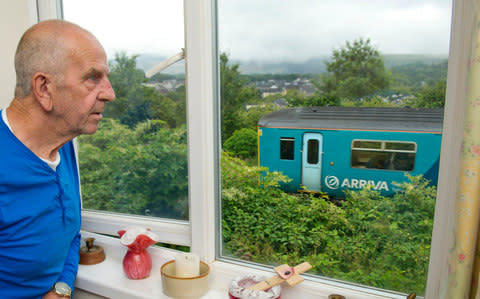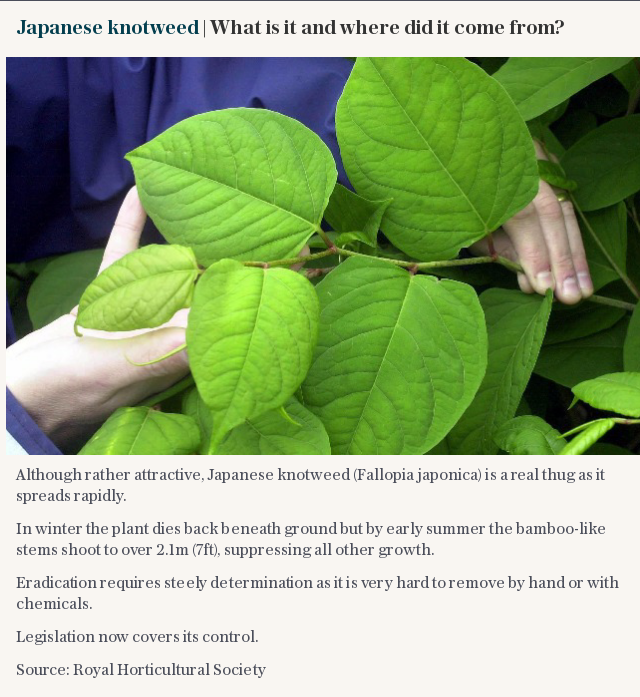'Japanese knotweed halved the value of my home, but Network Rail won't pay'

An elderly homeowner whose bungalow lost half of its value due to the spread of Japanese knotweed has now become embroiled in a legal battle with Network Rail over who will pay to eradicate the plant.
When the Victorians introduced Japanese knotweed to Britain thinking it would be a pretty addition to the herbaceous border, they could not have predicted the damage its rapid, uncontrolled spread would eventually cause.
It has swept across the country, largely carried by waterways and trains. Its mat-like roots undermine foundations, wiring and plumbing, and its presence can knock tens of thousands of pounds off house prices. In the worst cases it can render a property impossible to sell.
Robin Waistell, 70, returned from Spain in 2012 after the death of his wife and bought a small bungalow in the south Wales village of Maesteg.
Disaster struck a year later when he put it on the market for £130,000. A surveyor found knotweed on the property which had spread from the nearby railway line. As a result, Mr Waistell was forced to cut the asking price to a meagre £70,000.
Now he remains locked in a legal battle with Network Rail, which is currently appealing a county court decision, granted in February, that it should pay Mr Waistell £15,000 in damages - a sum which would include the costs of removing the plant.
“I’ve been given that money, but they’ve appealed the decision and so I can’t spend it on dealing with the knotweed,” he said. “Four years on I am really no further than I was in 2013. Network Rail doesn’t acknowledge I’m here.
“I think it’s a case of 'ignore the little man and he will go away'. But this little man isn’t going anywhere.”

Mr Waistell is being represented by solicitor Rodger Burnett, who founded knotweed specialist law firm Charles Lyndon after his own battle with Network Rail over the invasive plant. He said Japanese knotweed - the Latine name is Fallopia japonica - is now "ubiquitous" in railway cutting. This is because fragments of the plant attach to rolling stock and are thus distributed throughout Britain's network.
“Network Rail has a very significant problem,” Mr Burnett said. “No one is really maintaining the embankments so it tends to completely cannibalise the land in front of it. A significant volume of our cases are against Network Rail.”
He suggested the company is hoping householders will give up and then defending the few cases which do come to court. “They are basically burying their head in the sand,” he added.

Since setting up the firm two years ago, Mr Burnett has represented more than 200 clients in knotweed cases, many of them against Network Rail.
A spokesman for Network Rail said she could not comment on Mr Waistell’s case while proceedings are still ongoing. She added: “Once reported to us, Japanese knotweed growing on our land and within seven metres of our neighbours is included in a chemical treatment cycle until there is no knotweed growth.”

Japanese knotweed and mortgage lenders: the facts
It was once the case that mortgage lenders would turn down loan applications where the properties involved had knotweed present. This made it near impossible for sellers to get rid of properties.
This is no longer the case, but most lenders will want to see a treatment plan in place or a valid insurance policy covering the plant’s removal.
If left untreated it can cause severe damage to a property. The Royal Institute of Chartered Surveyors (RICS) warns drains and pipework, patios, paths and drives, boundary and retaining walls, outbuilding, conservatories and garden structures are especially at risk.
If you are looking to sell your property and you know there is a knotweed problem you are legally required to highlight it on the sellers’ form. Experts say the best way forward is to purchase an insurance policy which will cover the treatment, and can be passed to the new owners.
Alan Thorgood, CEO of the STL Group, a property information company, said: “We recommend if you have a medium or high risk you take out an insurance policy. These cost about £50 a month and will cover you for £20,000-worth of treatment. The homeowner can buy this and pass it on to the purchaser.”
What to do if you find the dreaded weed on your property
In short, it will need dealing with. It is an offence to allow Japanese knotweed to infect or spread onto someone else’s property and doing so can land you in hot water.
The Government has begun a biological control plan which involves introducing thousands of bugs known as "plant suckers". According to the Royal Horticultural Society the insects are currently being trialled at a few select test sites but, if successful, will be rolled out across Britain in the next five to 10 years.
Aside from this, the issue can be dealt with using either chemical or non-chemical controls. Both methods are expensive and can take as long as three years to fully take effect.
Non-chemical eradication involves the entire area being “dug out” - meaning the soil must be removed right down to the roots. The contaminated soil cannot be disposed of with normal household waste, however.
The chemical treatment uses a glyphosate-based weedkiller, which can be purchased over the counter.
It’s only a weed, can’t I deal with it myself?
It can be tempting to try and tackle the knotweed yourself. While success is possible, Graham Ellis, a director at RICS, warned that DIY efforts to control the weed can go wrong.
“The most important thing is to get the advice and to manage the situation properly,” he said. “People do try to cover it up or cut it back but the issue with Japanese knotweed is it will continue to reappear.
“If it’s cut back it will only come back all the more vigorously. If you have any concerns it’s best just to get a specialist in, it may cost you money in the short term but in the long term it could save the value of your house.”
Have you had trouble with Japanese knotweed? Email sam.meadows@telegraph.co.uk with your story


